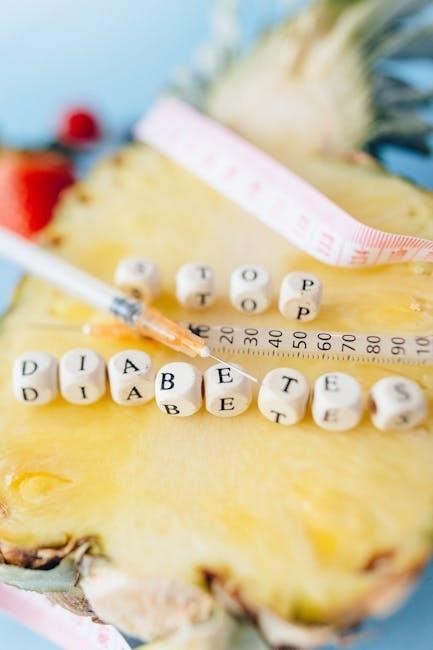The Eat to Beat Disease Food List PDF offers a comprehensive guide to selecting foods that support health and prevent disease. It provides a practical, organized approach to grocery shopping and meal planning, emphasizing whole, nutrient-rich foods. This resource is designed to help individuals make informed dietary choices, backed by scientific research, to promote overall well-being and resilience against chronic illnesses. With its easy-to-follow structure, it serves as a valuable tool for anyone aiming to harness the power of food for better health.

Overview of the Concept
The Eat to Beat Disease Food List PDF is based on the idea that food serves as a powerful tool for preventing and managing chronic diseases. This concept, rooted in scientific research, emphasizes the importance of whole, nutrient-dense foods in supporting the body’s natural health systems. By focusing on specific categories like fruits, vegetables, herbs, and lean proteins, the guide provides a clear framework for making dietary choices that promote longevity and well-being. The approach is centered on activating the body’s five health defense systems, which play a crucial role in preventing illness and maintaining optimal health. This practical resource empowers individuals to take control of their diet, offering a simple yet effective way to incorporate disease-fighting foods into daily meals. It bridges the gap between nutrition science and everyday eating, making healthy choices accessible and sustainable.

The Science Behind Food and Disease Prevention
Food plays a crucial role in preventing disease by providing essential nutrients that support cellular health and immune function. Specific compounds like polyphenols and fiber in whole foods aid in reducing inflammation and enhancing the body’s natural defenses, promoting longevity and overall well-being. By understanding how these nutrients work, individuals can make informed dietary choices to protect against chronic illnesses; This scientific approach to nutrition highlights the importance of selecting foods rich in antioxidants and anti-inflammatory properties, such as berries, turmeric, and leafy greens, to support optimal health and prevent disease effectively. This knowledge empowers individuals to use food as a proactive tool for maintaining wellness. The science underscores the profound impact of diet on health outcomes, encouraging a focus on nutrient-dense, whole foods to foster resilience and prevent disease. By aligning dietary choices with scientific evidence, individuals can harness the protective benefits of food to promote long-term health and well-being. This approach not only supports physical health but also contributes to mental clarity and energy, enabling a more vibrant and disease-free life. The connection between food and disease prevention is rooted in the body’s ability to heal and protect itself when provided with the right nutrients, making informed eating a cornerstone of preventive care. Eating to beat disease is not just a diet but a lifestyle choice backed by scientific research, offering a natural and sustainable path to optimal health. Through this lens, food becomes a powerful medicine, capable of preventing and managing a wide range of health conditions. By embracing this concept, individuals can take control of their health, reducing the risk of chronic diseases and improving their quality of life. The science behind food and disease prevention is a testament to the human body’s incredible ability to heal and thrive when nourished with the right foods. This understanding revolutionizes the way we view nutrition, transforming meals into opportunities to support health and prevent illness. The evidence is clear: food is a potent ally in the fight against disease, and making informed choices can lead to a longer, healthier life. By prioritizing whole, nutrient-rich foods, individuals can empower their bodies to function at their best, reducing the likelihood of chronic conditions and maintaining vitality. This scientific perspective on nutrition serves as a compelling reminder of the importance of diet in preventing disease and promoting overall well-being. Food is not just sustenance; it is a tool for health, and understanding its role in disease prevention is key to living a healthier, more resilient life. The science behind food and disease prevention offers a clear roadmap for making dietary choices that support health, empowering individuals to take an active role in their well-being. By aligning their diets with scientific evidence, people can harness the healing potential of food, reducing their risk of illness and enhancing their quality of life. This approach to nutrition is both practical and powerful, providing a natural and effective way to prevent disease and promote health. The connection between food and disease prevention is a vital area of study, offering insights into how diet influences health outcomes. By focusing on nutrient-dense foods, individuals can support their bodies in preventing and managing chronic conditions, leading to a healthier and more fulfilling life. The science behind food and disease prevention is a cornerstone of modern nutrition, guiding individuals toward dietary choices that promote longevity and well-being. By understanding the role of food in health, people can make informed decisions that empower their bodies to thrive, reducing the risk of disease and improving overall quality of life. This scientific approach to nutrition highlights the importance of whole, nutrient-rich foods in preventing chronic illnesses and supporting optimal health. By embracing this knowledge, individuals can take control of their health, using food as a powerful tool for disease prevention and wellness. The science behind food and disease prevention is a testament to the profound impact of diet on health, offering a natural and sustainable path to a healthier life. By prioritizing nutrient-dense foods, individuals can support their bodies in preventing disease, leading to a more resilient and vibrant life. This understanding of the relationship between food and health is essential for making informed dietary choices that promote longevity and well-being. The science behind food and disease prevention provides a clear and evidence-based guide for optimizing nutrition and reducing the risk of chronic conditions. By aligning their diets with scientific research, individuals can harness the protective benefits of food, leading to a healthier and more disease-free life. The connection between food and disease prevention is a fundamental aspect of preventive care, emphasizing the importance of whole, nutrient-rich foods in supporting health and reducing the risk of illness. By embracing this scientific approach to nutrition, individuals can empower their bodies to function at their best, promoting overall well-being and resilience. The science behind food and disease prevention is a powerful reminder of the importance of diet in maintaining health and preventing chronic conditions. By focusing on nutrient-dense foods, individuals can support their bodies in preventing disease, leading to a longer and healthier life. This understanding of the role of food in health is a cornerstone of modern nutrition, guiding individuals toward dietary choices that promote vitality and well-being. By prioritizing whole, nutrient-rich foods, people can reduce their risk of chronic illnesses and enhance their quality of life. The science behind food and disease prevention offers a clear and effective approach to optimizing nutrition, empowering individuals to take control of their health through informed dietary choices. By aligning their diets with scientific evidence, people can harness the healing potential of food, leading to a more resilient and disease-free life. The connection between food and disease prevention is a vital area of study, providing insights into how diet influences health outcomes. By focusing on nutrient-dense foods, individuals can support their bodies in preventing and managing chronic conditions, leading to a healthier and more fulfilling life. The science behind food and disease prevention is a testament to the profound impact of diet on health, offering a natural and sustainable path to a healthier life. By prioritizing whole, nutrient-rich foods, individuals can support their bodies in preventing disease, leading to a more vibrant and resilient life. This understanding of the relationship between food and health is essential for making informed dietary choices that promote longevity and well-being. The science behind food and disease prevention provides a clear and evidence-based guide for optimizing nutrition and reducing the risk of chronic conditions. By aligning their diets with scientific research, individuals can harness the protective benefits of food, leading to a healthier and more disease-free life. The connection between food and disease prevention is a fundamental aspect of preventive care, emphasizing the importance of whole, nutrient-rich foods in supporting health and reducing the risk of illness. By embracing this scientific approach to nutrition, individuals can empower their bodies to function at their best, promoting overall well-being and resilience. The science behind food and disease prevention is a powerful reminder of the importance of diet in maintaining health and preventing chronic conditions. By focusing on nutrient-dense foods, individuals can support their bodies in preventing disease, leading to a longer and healthier life. This understanding of the role of food in health is a cornerstone of modern nutrition, guiding individuals toward dietary choices that promote vitality and well-being. By prioritizing whole, nutrient-rich foods, people can reduce their risk of chronic illnesses and enhance their quality of life. The science behind food and disease prevention offers a clear and effective approach to optimizing nutrition, empowering individuals to take control of their health through informed dietary choices. By aligning their diets with scientific evidence, people can harness the healing potential of food, leading to a more resilient and disease-free life. The connection between food and disease prevention is a vital area of study, providing insights into how diet influences health outcomes. By focusing on nutrient-dense foods, individuals can support their bodies in preventing and managing chronic conditions, leading to a healthier and more fulfilling life. The science behind food and disease prevention is a testament to the profound impact of diet on health, offering a natural and sustainable path to a healthier life. By prioritizing whole, nutrient-rich foods, individuals can support their bodies in preventing disease, leading to a more vibrant and resilient life. This understanding of the relationship between food and health is essential for making informed dietary choices that promote longevity and well-being. The science behind food and disease prevention provides a clear and evidence-based guide for optimizing nutrition and reducing the risk of chronic conditions. By aligning their diets with scientific research, individuals can harness the protective benefits of food, leading to a healthier and more disease-free life. The connection between food and disease prevention is a fundamental aspect of preventive care, emphasizing the importance of whole, nutrient-rich foods in supporting health and reducing the risk of illness. By embracing this scientific approach to nutrition, individuals can empower their bodies to function at their best, promoting overall well-being and resilience. The science behind food and disease prevention is a powerful reminder of the importance of diet in maintaining health and preventing chronic conditions. By focusing on nutrient-dense foods, individuals can support their bodies in preventing disease, leading to a longer and healthier life. This understanding of the role of food in health is a cornerstone of modern nutrition, guiding individuals toward dietary choices that promote vitality and well-being. By prioritizing
How Nutrients Influence Health
Nutrients play a vital role in maintaining and improving health by providing the body with essential components for cellular function and repair. Foods rich in antioxidants, such as berries and leafy greens, help combat oxidative stress, while anti-inflammatory compounds like turmeric and omega-3 fatty acids reduce inflammation. Fiber supports gut health, promoting a strong immune system, and vitamins like vitamin C and D are crucial for immune function. Minerals such as zinc and magnesium aid in enzyme production and energy metabolism. These nutrients work synergistically to prevent chronic diseases, enhance cellular repair, and support the body’s natural defense systems. By consuming a diverse diet of whole foods, individuals can ensure they receive a broad spectrum of nutrients, empowering their bodies to function optimally and resist disease. This approach underscores the importance of nutrition in preventing illness and promoting longevity.

The Role of Whole Foods in Cellular Repair
Whole foods are essential for cellular repair, as they provide the necessary nutrients, vitamins, and minerals that support the body’s natural healing processes. These foods, such as fruits, vegetables, and herbs, are rich in antioxidants that combat oxidative stress and protect cells from damage. Fiber in whole foods promotes gut health, which is critical for immune function and the absorption of nutrients. Additionally, whole foods contain anti-inflammatory compounds, such as polyphenols and omega-3 fatty acids, which reduce inflammation and support tissue repair. By consuming a diet rich in whole foods, individuals can enhance their body’s ability to repair and regenerate cells, maintaining optimal health and reducing the risk of chronic diseases. This approach aligns with the concept of “food as medicine,” emphasizing the therapeutic potential of natural, unprocessed foods.
Activating the Body’s Five Health Defense Systems
The body’s five health defense systems—angiogenesis, cell regeneration, immune function, microbiome health, and inflammation control—play a crucial role in maintaining overall wellness. Specific whole foods can activate these systems, enhancing the body’s ability to prevent and fight disease. For example, foods like tomatoes, blueberries, and dark chocolate support angiogenesis, which helps starve cancer cells of nutrients. Leafy greens and fermented foods promote a healthy microbiome, while citrus fruits and mushrooms boost immune function. Turmeric and fatty fish, rich in omega-3s, reduce inflammation, protecting cells from damage. By incorporating these foods into your diet, you can activate these defense systems, fostering resilience against chronic illnesses and supporting long-term health. This approach emphasizes the transformative power of nutrition in maintaining bodily balance and preventing disease.

Comprehensive Food List for Disease Prevention
This organized guide categorizes foods like fruits, vegetables, herbs, seafood, meats, legumes, nuts, beans, mushrooms, and oils, providing a clear roadmap for making nutritionally informed choices to prevent disease.
Fruits: Berries, Citrus, and Tropical Varieties
Fruits are a cornerstone of the Eat to Beat Disease approach, offering vibrant flavors and rich nutrients. Berries like blueberries and blackberries are packed with antioxidants that combat inflammation and support brain health. Citrus fruits such as oranges, lemons, and grapefruits provide vitamin C, which bolsters the immune system and aids in collagen production. Tropical varieties like kiwi, mangoes, and papaya are abundant in vitamins A and C, potassium, and fiber, promoting digestion and energy. These fruits are versatile, adding nutrients to breakfasts, snacks, and desserts. Incorporating a mix of berries, citrus, and tropical fruits ensures a broad spectrum of vitamins and minerals, enhancing overall health and disease prevention. Their natural sweetness makes them an enjoyable way to nourish the body and support long-term wellness.
Vegetables: Leafy Greens, Cruciferous, and Root Vegetables
Vegetables are a cornerstone of the Eat to Beat Disease approach, offering a wealth of nutrients and health benefits. Leafy greens like spinach, kale, and collards are rich in vitamins A, C, and K, as well as minerals like calcium and iron, supporting immune function and bone health. Cruciferous vegetables such as broccoli, Brussels sprouts, and cauliflower contain sulforaphane, which has been shown to have anti-cancer properties and support detoxification. Root vegetables like carrots, beets, and sweet potatoes provide fiber, antioxidants, and essential vitamins, promoting digestion and energy. These vegetables are versatile and can be incorporated into meals in various forms, from salads to soups. Their diverse nutrient profiles make them a key component in preventing chronic diseases and fostering overall wellness.

Herbs and Spices: Turmeric, Cinnamon, and More
Herbs and spices are powerful additions to the Eat to Beat Disease approach, offering potent health benefits. Turmeric, with its active compound curcumin, is renowned for its anti-inflammatory and antioxidant properties, supporting joint health and immune function. Cinnamon, another standout, helps regulate blood sugar levels and improves circulation. Other beneficial spices include ginger, known for its digestive benefits, and garlic, which supports cardiovascular health. These ingredients not only enhance flavor but also provide medicinal properties that can aid in preventing chronic diseases. Incorporating them into meals adds depth and nutrition, making them a simple yet effective way to boost overall wellness.
Seafood: Fatty Fish and Shellfish
Seafood, particularly fatty fish and shellfish, plays a vital role in the Eat to Beat Disease approach due to their rich nutrient profiles; Fatty fish like salmon, mackerel, and sardines are abundant in omega-3 fatty acids, which reduce inflammation and support heart health. Shellfish such as mussels, oysters, and scallops are excellent sources of zinc, vitamin D, and antioxidants, benefiting immune function and cellular repair. These foods are also low in saturated fats and high in protein, making them a healthy choice for overall wellness. Incorporating seafood into your diet can help lower the risk of chronic diseases, including heart disease and cognitive decline. Their anti-inflammatory and immune-boosting properties make them a cornerstone of a disease-preventive diet, aligning with the principles of using food as medicine.
Meat: Grass-Fed and Lean Options
Grass-fed and lean meats are recommended in the Eat to Beat Disease approach for their nutritional benefits and lower risk of chronic diseases. Grass-fed beef, for instance, contains higher levels of omega-3 fatty acids and conjugated linoleic acid (CLA), which support immune function and reduce inflammation. Lean meats like chicken and turkey provide essential protein without excessive saturated fats. Choosing grass-fed over grain-fed options ensures higher vitamin A and E content, enhancing antioxidant intake. Moderation is key, as red meat can still pose health risks if consumed in excess. Opting for lean cuts and avoiding processed meats helps maintain a balanced diet. This section emphasizes the importance of quality over quantity, aligning with the food-as-medicine philosophy to promote longevity and overall well-being.
Legumes, Nuts, and Beans
Legumes, nuts, and beans are rich in protein, fiber, and essential nutrients, making them a cornerstone of the Eat to Beat Disease approach. These foods are packed with antioxidants, vitamins, and minerals that support overall health. Legumes like lentils, chickpeas, and black beans are high in fiber, promoting digestive health and stabilizing blood sugar levels. Nuts, such as almonds and walnuts, offer healthy fats and antioxidants that protect against inflammation and cardiovascular disease. Beans, including kidney and pinto beans, are excellent sources of plant-based protein and folate, which support cellular repair and energy production. Incorporating these foods into your diet can help lower cholesterol, improve immune function, and reduce the risk of chronic diseases. They are versatile and can be easily added to meals, making them a practical choice for a healthier lifestyle.
Mushrooms: Their Unique Health Benefits
Mushrooms are celebrated in the Eat to Beat Disease Food List PDF for their exceptional health benefits. Varieties like reishi, shiitake, and oyster mushrooms are rich in bioactive compounds that support immune function and reduce inflammation. These fungi contain polysaccharides, such as beta-glucans, which stimulate the immune system and enhance its ability to fight pathogens. Additionally, mushrooms are excellent sources of antioxidants like selenium and polyphenols, which protect cells from oxidative damage and promote longevity. They also contain prebiotic fibers that nourish gut microbiota, supporting digestive health and overall well-being. Incorporating mushrooms into meals can help lower the risk of chronic diseases, improve immune resilience, and contribute to a balanced diet. Their unique combination of nutrients makes them a powerful addition to any health-focused eating plan.
Oils, Sauces, and Condiments
Oils, sauces, and condiments play a vital role in enhancing the flavor and nutritional value of meals. The Eat to Beat Disease Food List PDF highlights healthy options like olive oil, avocado oil, and sesame oil, which are rich in antioxidants and heart-healthy fats. Herbs and spices, such as turmeric and cinnamon, are also emphasized for their anti-inflammatory and immune-boosting properties. Sauces like soy sauce and tamari, when used in moderation, add flavor while providing essential minerals. Condiments such as apple cider vinegar and mustard offer digestive benefits and anti-inflammatory effects. These ingredients not only elevate dishes but also contribute to overall health by supporting immune function, reducing inflammation, and promoting longevity. Incorporating them mindfully ensures meals are both delicious and nutritious, aligning with the principles of using food as medicine.

Daily Meal Plans for Optimal Health
The Eat to Beat Disease Food List PDF provides structured daily meal plans, offering balanced and nutrient-rich recipes for breakfast, lunch, dinner, and snacks. These plans are designed to promote health and prevent disease through scientifically backed food choices, ensuring variety and simplicity for sustainable eating habits.
Breakfast Recipes to Start Your Day
Begin your day with nutrient-packed breakfast recipes from the Eat to Beat Disease Food List PDF. Enjoy options like berry smoothies, spinach omelets, or whole-grain toast with avocado. These recipes emphasize fruits, vegetables, and whole grains to provide sustained energy and support overall health. Incorporate ingredients like turmeric, cinnamon, and nuts for added anti-inflammatory and antioxidant benefits. Smoothies with citrus fruits and leafy greens offer a quick, nutritious start, while overnight oats provide fiber and protein. Each recipe is designed to boost immunity, reduce inflammation, and kickstart your metabolism. With these simple, delicious ideas, you can create balanced breakfasts that align with your health goals and keep you feeling energized throughout the morning.

Salads and Soups for Lunch
Nourish your midday with fresh salads and hearty soups from the Eat to Beat Disease Food List PDF. Salads featuring leafy greens, cruciferous vegetables, and colorful berries provide a rich mix of vitamins and antioxidants. Add citrus vinaigrettes or herbs like turmeric and cinnamon for enhanced flavor and anti-inflammatory benefits. Soups, such as vegetable-based broths with root vegetables like sweet potatoes and carrots, offer comforting, nutrient-dense options. Incorporate mushrooms for immune support and legumes for protein. These recipes are designed to boost energy, support detoxification, and promote overall vitality. With creative combinations of whole foods, you can enjoy flavorful and nutritious lunches that align with your health goals and keep you satisfied until dinner.
Healthy Entrees for Dinner
Dinner is a great opportunity to refuel with nutrient-dense, flavorful dishes from the Eat to Beat Disease Food List PDF. Opt for entrees rich in lean proteins like grass-fed meats, fatty fish, or plant-based options such as legumes and beans. Pair these with a variety of colorful vegetables, including leafy greens, cruciferous varieties, and root vegetables, to maximize nutritional benefits. Herbs and spices like turmeric, cinnamon, and black pepper add anti-inflammatory properties while enhancing flavor. Incorporate healthy fats from sources like olive oil or avocado to support heart health and satiety. Seafood options, such as salmon or shellfish, provide essential omega-3 fatty acids. These balanced meals are designed to energize your body, support immune function, and promote long-term health, ensuring a satisfying end to your day with a focus on wellness.
Desserts with Nutritional Value
Desserts can be both indulgent and nutritious when made with ingredients from the Eat to Beat Disease Food List PDF. Opt for desserts rich in antioxidants, such as dark chocolate, which contains flavonoids that support heart health; Fresh berries, like blueberries and blackberries, are excellent choices due to their high antioxidant content. Incorporate plant-based ingredients like nuts, seeds, and whole grains to add fiber and texture. Desserts featuring fruits, such as baked apples or poached pears, provide natural sweetness and essential vitamins. Even small portions of these nutrient-dense treats can satisfy cravings while supporting overall health. By focusing on whole, unprocessed foods, you can enjoy desserts that align with your goal of using food as medicine, making every meal a step toward wellness.

Shopping Guide for Healthy Eating
The Eat to Beat Disease Food List PDF provides a structured shopping guide, categorizing foods like fruits, vegetables, and proteins. It offers practical tips for selecting fresh, nutrient-rich ingredients and organizing your grocery list to make healthy eating easier and sustainable. By focusing on whole foods and avoiding processed items, this guide helps you create a foundation for meals that support disease prevention and overall wellness. It emphasizes the importance of quality and variety, ensuring your diet is both nourishing and enjoyable.
Organizing Your Grocery List
Organizing your grocery list is a key step in maintaining a healthy diet. The Eat to Beat Disease Food List PDF provides a structured approach, categorizing foods into groups like fruits, vegetables, proteins, and more. This makes it easier to ensure you cover all nutritional bases. Start by listing essentials from each category, checking what you already have at home to avoid waste. Focus on fresh, whole foods and include variety to meet daily nutritional needs. The guide also suggests using the 5-5-5 Daily Worksheet to plan meals and snacks, ensuring a balanced intake of fruits, vegetables, and proteins. By organizing your list this way, you can streamline grocery shopping and make healthy eating more sustainable. This method helps reduce decision fatigue and ensures you always have the right ingredients on hand for nourishing meals.
Tips for Selecting Fresh Produce
Selecting fresh produce is crucial for maximizing nutritional benefits. The Eat to Beat Disease Food List PDF offers practical tips to help you choose the best fruits and vegetables. Look for vibrant colors, as they often indicate higher nutrient content. For fruits, opt for those with no visible bruises or soft spots, ensuring they’re ripe but firm. With vegetables, choose those with crisp leaves and avoid wilted or blemished items. Seasonal produce tends to be fresher and more flavorful, so consider what’s in season when shopping. Additionally, the guide suggests buying organic when possible, especially for foods with thin skins, to minimize pesticide exposure. By following these tips, you can ensure your meals are not only delicious but also packed with nutrients to support your health goals. Fresh, high-quality ingredients are the foundation of a disease-fighting diet.

Creating Your Personalized Food List
Personalize your diet by selecting health-promoting foods you enjoy. Use the master list from the Eat to Beat Disease Food List PDF to tailor choices that suit your preferences and needs. Incorporate favorites while ensuring variety to maximize nutritional benefits and support long-term health goals effectively.
Identifying Favorite Foods for Health
Identifying favorite foods for health involves selecting nutrient-rich options that you enjoy and that align with your dietary goals. Start by reviewing the Eat to Beat Disease Food List PDF and highlighting foods you already love or are willing to try. Focus on variety to ensure a broad range of vitamins, minerals, and antioxidants. Incorporate colorful fruits like berries and citrus, along with leafy greens, herbs, and spices, which are known for their anti-inflammatory and immune-boosting properties. Consider whole foods, such as fatty fish, lean meats, and legumes, that provide sustained energy and support cellular repair. By prioritizing flavors and textures you enjoy, you can create a personalized diet that is both satisfying and health-promoting, making it easier to stick to long-term wellness goals. This approach ensures your meals are enjoyable while maximizing their nutritional benefits for optimal health outcomes.
Using the 5-5-5 Daily Worksheet
The 5-5-5 Daily Worksheet is a structured tool designed to help individuals plan and track their meals effectively. It encourages users to include 5 servings of fruits, 5 servings of vegetables, and 5 servings of other nutrient-dense foods each day. By breaking down daily intake into these categories, the worksheet simplifies the process of ensuring a balanced diet. Users can refer to the Eat to Beat Disease Food List PDF to identify foods that align with each category, making meal planning both efficient and enjoyable. This method not only promotes variety but also helps maintain consistency in consuming foods that support immune function, reduce inflammation, and enhance overall health. Regular use of the 5-5-5 worksheet can lead to sustainable habits, making it easier to incorporate healthier choices into daily life. This approach is both practical and effective for achieving long-term wellness goals.


